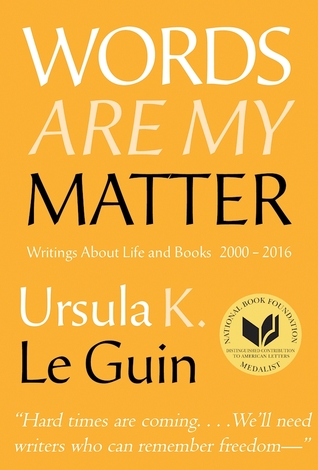The last of the pieces in Words Are My Matter: Writings about Life and Books 2000-2016 and one of the longer ones, “The Hope of Rabbits” is a record of the time Ursula K. Le Guin spent at Hedgebrook, on the coast of Whidbey Island north of Seattle.
She was invited there for a month, more than twenty years ago, and she agreed to stay for a single week.
“Seven days with no obligations, no routine, no society except at dinner time – but not exactly vacation days, not holiday: workdays for the real work, without any distractions except those I invent.”
Much of the week’s writing is filled with her observations about her surroundings, in particular – as one would guess from the title – the many rabbits that live there, watching the writers come and go.
Her writer’s eye also captures other situational details that invite the reader into her space there, like the type of wood from which a door is made or the sort of work done in the garden on the Saturday.
Living arrangements there are integrally connected to the natural world, which seems largely peaceful and contemplative.
Although there is room for some self-deprecating humour too.
“I suddenly realized that I can get rid of the flies in my windowseat windows, which come in the door and buzz and distract me, by opening the windows. The flies fly out. Ma che stupidezza!”
(This is just the kind of “discovery” that I can imagine myself making, caught in the flurry of a draft, irritated by some detail, for which there is a simple solution that only later becomes clear to me in an embarrassingly obvious way.)
There is some consideration about the fact that only women writers visit Hedgebrook (and the introduction to the piece debates the merits of and need for such a space, in this patriarchal society) and about how a male writer who might have stayed in her particular cabin might have responded to the space therein.
She explains the process of decision-making which governed her packing, which books she chose to bring with her and which she left behind. And almost immediately she notices differences in her work habits which appeal to her.
“I think about the humane pace of longhand, and how one is constantly looking away from the notebook a things around it, near or far, changing position as one sits, doodling in the margin while working out a transition, half-consciously noticing the slant of the sunlight, the advance of shadows, the color of the sky, fully absorbed in the work, and yet open to the surrounding world, as we are not when working at a computer screen.”
The emphasis, overall, in on her interior experience of the week, with only brief mentions of social interactions (which made her anxious in advance but which were, ultimately, positive experiences).
“I am nearing the end of my story, which may be accommodating itself to my time here – I suspect it of doing so. But it’s 41 pages now and should not go on forever, surely? It leaps about strangely, as it is, I think I know what it’s about and then I am not certain.”
The emphasis is always on the work and she is not afraid to question and explore, not afraid to say that she still questions and explores even as an accomplished and decorated writer. (I’ve written about Le Guin’s about writing about writing here and here, as well.)
Good stuff for writers.
Le Guin, Ursula K. “The Hope of Rabbits: The Journal of a Writer’s Work” in Words Are My Matter: Writings about Life and Books 2010-2016 (Small Beer Press, 2016)

